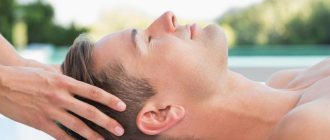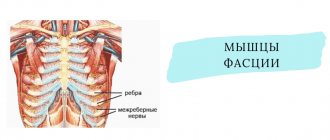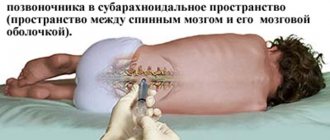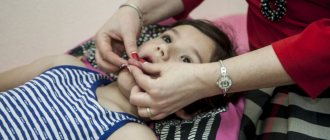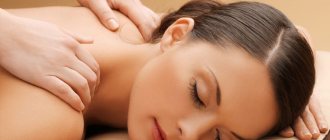What is intercostal neuralgia?
Intercostal neuralgia is a syndrome characterized by the appearance of severe pain in the space between the ribs . The pain occurs due to compression of the nerve endings that pass between the ribs.
The nerves passing between the ribs cause intercostal neuralgia when they are compressed and inflamed
Neuralgia may be:
- radicular, in which the nerve fibers passing in the spine are pinched;
- reflexive, it is caused by muscle spasm in the space between the ribs.
The disease is not life-threatening, but significantly worsens its quality. After all, due to the pain syndrome, the patient sleeps poorly, his irritability increases, and hypertensive crises may occur.
Indications and contraindications
Therapeutic massage is indicated in cases where intercostal neuralgia is caused by muscle spasms or diseases of the spinal column, and the pain syndrome is moderate. With severe pain, even the lightest touch to the affected areas is painful for the patient, which means there will be no benefit from such a procedure.
Massage is indicated for moderate pain in the rib area.
As for contraindications, in addition to acute pain, these include:
- inflammatory processes in the body;
- the presence of viral and bacterial infections;
- malignant and benign tumors;
- physical exhaustion;
- dermatological diseases, especially purulent ones;
- injuries to the ribs, chest and spine.
For rib injuries, massage is contraindicated.
Also, do not massage if you have high blood pressure or general malaise. To accurately determine the cause of the disease and make sure there are no contraindications, you need to undergo a full examination, and based on its results, the doctor will determine whether a massage can be prescribed.
Important! An experienced, qualified massage therapist should carry out the procedure (at least the first few sessions), and only if there is a lasting improvement and after consultation with a doctor, massage is allowed at home.
What are the main methods of treating intercostal neuralgia?
If pain occurs in the intercostal space, you should contact a neurologist as soon as possible. The doctor will assess the condition and select the most appropriate treatment tactics. Most often, drug treatment is prescribed.
Doctors prescribe injections and ointments, tablets that help relieve inflammation and relieve pain. At the same time, B vitamins are prescribed, which have a positive effect on the condition of nerve endings.
In addition, neurologists prescribe:
- physiotherapy;
- wearing belts and corsets that limit mobility;
- massage;
- exercise therapy;
- manual therapy;
- reflexology.
In advanced cases, surgery is recommended.
The causes of spasms and, consequently, attacks of neuralgia may be the following:
- hypothermia;
- lung diseases;
- mental stress;
- traumatic effects;
- past infectious diseases;
In addition, intercostal neuralgia develops due to poisoning and changes in the spine, which are caused by hormonal disorders in women during menopause. Various allergic reactions and diseases of the nervous system, in particular, such as polyradiculoneuritis and multiple sclerosis, also lead to this disease.
Intercostal neuralgia tends to occur with aortic aneurysms and certain diseases of the internal organs. The disease also develops after a herpetic infection.
With systematic physical stress, for example, when lifting heavy objects, microtraumas often lead to neuralgia, especially if they are combined with hypothermia.
Intercostal neuralgia is provoked by alcohol, since it has a toxic effect on the human nervous system. Diabetes mellitus and a lack of B vitamins (with stomach ulcers, hepatitis, gastritis and colitis) also lead to the disease, since metabolic disorders occur in the nervous tissues.
The use of massage for intercostal neuralgia
Massage is an independent therapeutic tool that can be used to reduce the severity of pain. But it is often used as one of the components of complex treatment . It is combined with medication, physiotherapy, manual therapy, and exercise therapy.
Before prescribing a massage, the patient must be examined. If the cause of pain is a tumor, then massage procedures are contraindicated. Due to increased blood flow, the tumor may begin to grow faster.
What are the benefits and how massage can help with intercostal neuralgia
With massage you can:
- strengthen the muscle corset;
- eliminate muscle tightness;
- improve blood flow in tissues;
- stimulate local metabolic processes.
The main benefit of massage is the elimination of muscle spasms, which contribute to pinched nerves.
The main cause of severe pain is muscle spasm , because of which the pain goes from acute to chronic. Massage allows you to remove spasm , thereby reducing the severity of pain.
When can you have a massage?
Massage procedures are prescribed only after the acute stage of the disease has passed. The patient should not complain of severe pain that interferes with speaking, inhaling deeply, or bowel movements. .
If you consult a doctor in a timely manner and prescribe adequate treatment, 4-5 days pass from the moment severe pain appears until the acute stage subsides. After this, the doctor can give a referral to a massage therapist to consolidate the effect obtained from drug therapy. Often, drug treatment continues and can be combined with medication.
Contraindications to the use of massage for intercostal neuralgia
Before prescribing treatment and massage, the patient is sent for a comprehensive diagnosis. The doctor needs to find out the reason why the nerve roots are pinched. In some pathologies, massage is prohibited.
Massage is not prescribed in such cases:
- acute infectious and inflammatory processes, due to increased blood flow, the infection spreads throughout the body;
- purulent skin lesions, dermatological diseases;
- severe exhaustion of the body;
- high blood pressure, hypertension;
- oncological diseases;
- mental illness;
- epilepsy;
- hereditary blood diseases in which there is an increased tendency to thrombosis and bleeding (thrombophlebitis, severe atherosclerosis, hemophilia, hemorrhagic vasculitis);
- disruption of intestinal function (dysbacteriosis, diarrhea).
In such situations, massage can worsen the patient's condition.
Video: “How to treat intercostal neuralgia at home?”
Pay attention to the following material:
- How and what kind of massage is given to children with scoliosis?
- You can read about the principle of correcting kyphosis with the help of massage and its benefits in general on the page
- What massage techniques are used to eliminate sciatica are described in the following article
- Instructions for performing massage for osteochondrosis of the thoracic region can be found here
- To find out if you can massage a bulging disc, go here
Massage for sciatica
Yoga
It is acceptable when acute attacks of pain have already been stopped. Exercises are not intended for a sick body and can make the situation worse.
In addition, asanas (yoga poses) require proper breathing, sometimes abdominal breathing is needed, and sometimes chest breathing. It is better to breathe while relaxing your abdominal muscles to relieve stress from the intercostal spaces.
Staying in an uncomfortable position for a long time, which is typical for yoga, can cause spasms or lumbago.
Based on all that has been said above, we can conclude that it is advisable to do yoga for intercostal neuralgia under the supervision of a specialist, and if this is not possible, then before starting yoga you should undergo a course of exercise therapy and make sure that there is no pain.
Simple asanas:
- Tadasana. Place your arms along your body, connect your heels, straighten your chest, tighten your stomach. Stay in this position for several minutes. Abdominal breathing. This asana is aimed at restoring the energy of the body.
- Vrikshasana - from the tadasana pose, raise your arms, join your palms, throw your head back (as far as possible), bring your shoulder blades together as much as possible. Hold the pose for as long as possible. Abdominal breathing.
- Varibhadrasana - standing with a straight back, place your palms near your chest, legs slightly apart. Turn your body slightly to the side, raise both arms and one leg. The back should be arched. Hold this position for a few seconds, then repeat the exercise in the other direction. Breathing while performing the asana is abdominal.
- Bhujangasana - snake pose. Lie on your stomach, while inhaling, lift the front of your body, and while exhaling, bend back. This asana strengthens the muscles of the entire spine. Abdominal breathing.
- Ardha navasana - half boat pose. From a lying position on your back, simultaneously raise your straight legs and body. Pull your arms forward. The pelvis and lower back are pressed tightly to the floor. Hold the pose for 5 seconds, then lower your body and legs to the floor and relax. Repeat 2-3 times. This pose is very good at relieving tension in the pectoral muscles. Abdominal breathing.
We advise you to study – Quadratus lumborum muscle
Video about yoga for intercostal neuralgia - pain when inhaling, under the shoulder blade:
Types of massage used for intercostal neuralgia
After severe pain subsides, the patient can go to the massage therapist. To alleviate the condition and reduce pain, the specialist will knead the back and chest. Patients are prescribed therapeutic or acupressure massage.
Classic therapeutic massage procedures allow:
- stimulate blood flow in small arteries and capillaries;
- warm up the skin and tissues that are under it;
- strengthen metabolic processes;
- improve the functioning of the nervous system, the conduction of nerve impulses;
- speed up the process of removing toxins and other substances that are involved in the inflammatory process.
When performing acupressure, a specialist acts on biologically active points . Finger piercing, pressure, kneading, and nail pricking are used. To reduce the severity of pain, use strong and medium-duration exposure from 2 to 5 minutes.
Points affected during thoracalgia
Massage technique
To perform a massage at home, it is enough to watch how an experienced specialist does it 1-2 times. The massage technique is quite simple and includes standard techniques - stroking with fingertips, kneading, rubbing painful areas.
Table. Stages of performing a massage
Description
Step 1
The patient lies on his stomach and places his hands in front of him. Massage begins on the side where there is no pain or is felt weaker. The fingertips are applied to the skin between the ribs and smoothly moved in the direction from the spine to the abdomen. Stroking is carried out with both hands, alternately running your fingers from top to bottom.
We advise you to study - Treatment of hernia of the lumbosacral spine
Step 2
After warming up the muscles on the healthy side of the back, move to the sore side. The movements are the same: fingers are placed on the back at an angle of 35-40 degrees, pressed with pads to the skin and passed between the ribs for 2-3 minutes.
Step 3
Switch over to the healthy side again and begin rubbing. The fingers are placed in the same way as before, but now the movements are more intense. For convenience, you can massage with one hand, pressing from above with the palm of your second hand. They rub not only the ribs, but also the area of the shoulder blade. Then repeat in the same way on the sore side of the back.
Step 4
The next stage is kneading. Again, start from the healthy side: place both palms on the ribs, then alternately raise and lower them, grasping the folds of the skin. The movements are intense, quite fast, and involve the area of the ribs and shoulder blade.
Step 5
Move to the sore side of the back
Here you should rub more carefully, but still quite actively. Step 6
The next technique is called vibration
To do this, grab the skin on the back with your fingers, lift it up and release it, that is, perform frequent pinching throughout the entire area being worked on. Having completed on one side, do the same on the other.
Step 7
After vibration, they again move on to stroking the intercostal space with their fingers. The movements are smooth, with light pressure, in the direction from the spine to the stomach.
Step 8
The patient should roll over onto his back and extend his arms along his body. Begin chest massage with classic stroking: apply palms to the skin and move from the middle of the chest to the back, then to the collarbones and at the same time with both hands from the neck to the stomach.
Step 9
Now stroking is done with the fingertips, moving between the ribs in the direction from the middle of the chest to the back.
Step 10
Start kneading. The movements are fast, active, from the lower line of the ribs to the collarbone. When properly kneaded, the skin should begin to turn red.
Step 11
After kneading, vibration is performed alternately on each side. The pinching should be moderately intense, but not painful.
Step 12
The massage is completed by stroking the entire treated area - from the stomach to the neck. The movements are very light, relaxing, smooth.
If the patient feels pain in a specific point, it is necessary to work on this area separately. You need to massage carefully, first performing stroking, then rubbing and kneading movements. It is not advisable to use pinches here, so as not to cause suffering to the patient. The duration of such work should not exceed 4-5 minutes. After this, the person should lie quietly for 10 or 20 minutes so that the muscles calm down. Instead of classical massage, cupping and acupressure massage can also be used for intercostal neuralgia.
Types of massage for intercostal neuralgia
Video - Massage for intercostal neuralgia
Technique and features of implementation for intercostal neuralgia
Did you know that...
Next fact
The massage is done in the back and chest area . Before starting it, the massage therapist must clarify on which side and at what level the painful sensations are concentrated.
Begin the massage on the opposite side from the place where the pain is concentrated . The specialist gradually moves from healthy areas to problematic areas. The massage therapist begins to work on the affected area after the 3rd session.
If intercostal neuralgia provokes the appearance of pain on both sides, then the treatment begins from those places where the discomfort is less pronounced. The massage is done as carefully as possible the first time. Over time, the intensity and strength of the impact can be increased.
To perform a massage, the patient is first placed on a massage table on his stomach . A special pillow is placed under the chest. After complete treatment of the back, the patient turns over, the specialist continues to massage, working on the muscles of the chest.
For intercostal neuralgia, about 10-15 massage sessions are usually prescribed. Most people experiencing intercostal neuralgia are prescribed 10-15 sessions . The duration of the first of them should not be more than 15 minutes. Over time it increases.
In the absence of contraindications, warming ointments are used. Pain-relieving ointments and gels can be applied to problem areas after the massage is completed.
To carry out the massage, the patient is placed on his stomach, and his arms are asked to be extended along the body. First, the back is stroked with both hands on both sides. The movement is repeated 7–9 times.
Then they begin squeezing on the healthy part of the back. Make it with the edge of the palm. The movement occurs in the direction from the long dorsi muscle down towards the couch.
Having completed this combined stroking, the massage therapist can proceed to kneading. The procedure begins with the long muscles of the back.
Experts recommend performing it according to this scheme:
- kneading with 4 fingertips (repeat 3-4 times);
- stroking with 2 hands (2–3 times);
- impact with the finger phalanges, while the palms are clenched into a fist (3–4 times).
The kneading ends with stroking to soothe the sore muscles.
After treating the long back muscle, they move on to the latissimus.
To warm it up and warm up, use the following techniques::
- ordinary kneading (3-4 times);
- shaking, carried out in the direction from the iliac crests to the armpits (2-3 repetitions);
- double ring kneading (3-4 times);
- shaking (2-3 times);
- stroking (3 times).
The complex on the healthy side is repeated 2-3 times, then the massage therapist can move to the sore side. The impact on it should be less intense. You should focus on the patient’s well-being.
The techniques described are the preparatory stage of massage. After it is carried out, they proceed to rubbing the spaces between the ribs where pain is felt. It should be carried out in the direction from the spinous vertebral processes along the spaces between the ribs, through the long back muscle. The massage therapist should use his fingertips to get into the grooves between the ribs to the maximum depth. Treatment begins from below the waist.
After completion, the patient is asked to turn over on his back. The development of the pectoral muscles begins with stroking and squeezing movements (3-4 repetitions).
Then the following complex is performed:
- shaking (2-3 repetitions);
- kneading (4–6 times);
- alternating stroking and shaking (3 times).
After completing the warm-up of the pectoral muscles, proceed to the intercostal muscles . The massage therapist rubs in a circular, zigzag, straight line direction from the sternum to the pectoralis major muscle (up to the breast gland in women), then he moves down to the back. Each technique is repeated 3-4 times.
Familiarize yourself with the technique and sequence of massage procedures for thoracalgia. Afterwards, the massage therapist should rub the subcostal angle . When performing a massage, the fingers are positioned so that 4 of them go deep under the hypochondrium, and the thumb remains on top. Rub them from the center of the sternum down to the couch. After 3-4 repetitions, stroking, squeezing, rubbing, kneading movements are performed on the treated area. Repeat them 2-3 times.
The anterior and lateral parts of the chest are massaged separately. The specialist should work by stroking and squeezing the pectoralis major muscles, the movements are repeated 3-4 times. Then he rubs the intercostal spaces in the direction from the sternum to the back. You need to move your hands as far as possible.
Repeat straight, spiral, circular, zigzag rubbing 3-4 times, which is done with the pads of 4 fingers. After rubbing, begin squeezing with the heel of your palm along the ribs. Then alternate stroking and squeezing movements.
After completion, carry out ordinary kneading (4 times) , kneading with the finger phalanges, while the palms are clenched into a fist (3 times). These movements alternate with stroking and shaking (2 times each).
After completing this complex, they begin to rub the spaces between the ribs . To do this, the hand on the treated side is placed behind the head, and the massage therapist performs the following movements:
- zigzag stroking along the ribs towards the iliac fossa, along the torso (3-4 repetitions);
- squeezing with the bases of the palms (5 repetitions), movements are directed along the ribs;
- straight, zigzag rubbing (each 3-4 repetitions);
- squeezing (3 times).
After this, the patient should take a deep breath several times, leaning to the healthy side, clasp his hands, raise his arms up and lower them to his hips. To complete the procedure, the patient turns on his stomach, and the massage therapist strokes, squeezes, shakes, and kneads the latissimus dorsi muscle.
During the massage or after its completion, you can use warming ointments and creams..
Video: “Massage for intercostal neuralgia: technique”
Massage technology
The total duration of the treatment course is 10 massage sessions performed daily. The duration of each session is from 10 minutes to half an hour. Such treatment should begin a few days later (maximum 7 days) from the onset of the disease and its adequate treatment with medications so that the pathological processes become less acute. Also, in case of frequent exacerbations of intercostal neuralgia, a massage procedure can be carried out to prevent these conditions.
There is no specific preparation for massage. If possible, it is better to conduct all sessions in the first half of the day (due to the specifics of the nervous system).
The patient is asked to take a horizontal position on a hard couch, lying on his stomach. Each massage session begins with the back area. A doctor or massage therapist first works with the healthy half of the body, gradually moving on to the affected one. In the case where the neuralgia is bilateral, the massage begins with the part in which the pain syndrome is less pronounced.
Back massage
Back massage can be divided into several stages, each of which has specific goals and functions:
- Stroking the entire surface of the back, starting with the least painful one. This is necessary in order to warm up the skin, prepare it for deeper movements, stretch the upper layers of muscle tissue, allowing the superficial structures to relax. Stroking is carried out with the base of the palm. The first movements are from bottom to top (from the pelvic bones to the shoulder blades), then from the spinous processes of the vertebrae towards the ribs, to the lateral surfaces of the body. This stage takes about 2 minutes.
- Squeezing. This technique is also performed with the base of the palm. The movements are stronger and penetrate not only the skin structures, but also the subcutaneous tissue and superficial layers of muscle tissue. The sliding and pressure of the massage therapist's hands should be of such intensity that the skin gathers into folds, without causing pain. The duration of the stage is about 2-3 minutes.
- Kneading. The long back muscles, trapezius muscles, latissimus dorsi muscles and intercostal spaces are kneaded in stages. The pressure should be deep enough, but not exceed the pain threshold. This stage involves the pads of the fingers, phalanges of bent fingers, the base of the palm, pinching, etc. The duration of this stage is about 5-10 minutes.
We advise you to study - Spinal puncture
Chest massage
Chest massage is carried out in a horizontal position, lying on your back, is also divided into several stages and begins with the healthy or less affected half of the body:
- Stroking. Straight-line or circular stroking with the palmar surface of the hand is aimed at relaxing, warming up, superficial kneading and preparing for deeper and more intense movements of the pectoralis major muscles. Duration 1-2 minutes. The patient should not experience pain or discomfort.
- Squeezing. This stage involves more intense and deeper pressure on the skin and superficial muscle fibers in the area of the pectoralis major muscles. Movements should be made with the palm of the hand so that the skin gathers into folds. This stage aims to relax the superficial layers of muscles, warm the skin and prepare the patient for the next stage. Duration 2-3 minutes.
- Kneading of the pectoralis major muscles is done with the pads of the fingers and phalanges of bent fingers. Movements should be both circular and linear. The pain sensitivity threshold must not be exceeded. The duration of the stage is 5-7 minutes.
- Rubbing the intercostal spaces. Just like the previous stage, it is performed either with the pads of the thumb or with all four others. Both linear and circular movements are possible. Raising the pain threshold is unacceptable. Duration is 5-7 minutes. The last two stages are aimed at relaxing, warming and reducing muscle spasm, which leads to a reduction in pain and restoration of nerve fibers.
